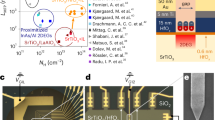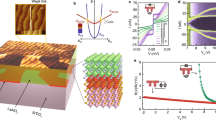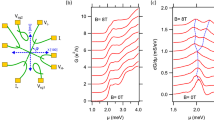Abstract
Strontium titanate (SrTiO3) is the first and best known superconducting semiconductor1. It exhibits an extremely low carrier density threshold for superconductivity2, and possesses a phase diagram similar to that of high-temperature superconductors3,4—two factors that suggest an unconventional pairing mechanism. Despite sustained interest for 50 years, direct experimental insight into the nature of electron pairing in SrTiO3 has remained elusive. Here we perform transport experiments with nanowire-based single-electron transistors at the interface between SrTiO3 and a thin layer of lanthanum aluminate, LaAlO3. Electrostatic gating reveals a series of two-electron conductance resonances—paired electron states—that bifurcate above a critical pairing field Bp of about 1–4 tesla, an order of magnitude larger than the superconducting critical magnetic field. For magnetic fields below Bp, these resonances are insensitive to the applied magnetic field; for fields in excess of Bp, the resonances exhibit a linear Zeeman-like energy splitting. Electron pairing is stable at temperatures as high as 900 millikelvin, well above the superconducting transition temperature (about 300 millikelvin). These experiments demonstrate the existence of a robust electronic phase in which electrons pair without forming a superconducting state. Key experimental signatures are captured by a model involving an attractive Hubbard interaction that describes real-space electron pairing as a precursor to superconductivity.
This is a preview of subscription content, access via your institution
Access options
Subscribe to this journal
Receive 51 print issues and online access
$199.00 per year
only $3.90 per issue
Buy this article
- Purchase on Springer Link
- Instant access to full article PDF
Prices may be subject to local taxes which are calculated during checkout




Similar content being viewed by others
References
Schooley, J. F., Hosler, W. R. & Cohen, M. L. Superconductivity in semiconducting SrTiO3 . Phys. Rev. Lett. 12, 474–475 (1964)
Lin, X., Zhu, Z., Fauqué, B. & Behnia, K. Fermi surface of the most dilute superconductor. Phys. Rev. X 3, 021002 (2013)
Caviglia, A. D. et al. Electric field control of the LaAlO3/SrTiO3 interface ground state. Nature 456, 624–627 (2008)
Richter, C. et al. Interface superconductor with gap behaviour like a high-temperature superconductor. Nature 502, 528–531 (2013)
Ueno, K. et al. Electric-field-induced superconductivity in an insulator. Nature Mater. 7, 855–858 (2008)
Eagles, D. M. Possible pairing without superconductivity at low carrier concentrations in bulk and thin-film superconducting semiconductors. Phys. Rev. 186, 456–463 (1969)
Binnig, G., Baratoff, A., Hoenig, H. E. & Bednorz, J. G. Two-band superconductivity in Nb-doped SrTiO3 . Phys. Rev. Lett. 45, 1352–1355 (1980)
Ohtomo, A. & Hwang, H. Y. A high-mobility electron gas at the LaAlO3/SrTiO3 heterointerface. Nature 427, 423–426 (2004)
Reyren, N. et al. Superconducting interfaces between insulating oxides. Science 317, 1196–1199 (2007)
von Delft, J., Zaikin, A. D., Golubev, D. S. & Tichy, W. Parity-affected superconductivity in ultrasmall metallic grains. Phys. Rev. Lett. 77, 3189–3192 (1996)
Tinkham, M., Ralph, D. C., Black, C. T. & Hergenrother, J. M. Discrete energy levels and superconductivity in nanometer-scale Al particles. Czech. J. Phys. 46, 3139–3145 (1996)
Cen, C. et al. Nanoscale control of an interfacial metal-insulator transition at room temperature. Nature Mater. 7, 298–302 (2008)
Cen, C., Thiel, S., Mannhart, J. & Levy, J. Oxide nanoelectronics on demand. Science 323, 1026–1030 (2009)
Veazey, J. P. et al. Oxide-based platform for reconfigurable superconducting nanoelectronics. Nanotechnology 24, 375201 (2013)
Cheng, G. L. et al. Sketched oxide single-electron transistor. Nature Nanotechnol. 6, 343–347 (2011)
Hanson, R., Kouwenhoven, L. P., Petta, J. R., Tarucha, S. & Vandersypen, L. M. K. Spins in few-electron quantum dots. Rev. Mod. Phys. 79, 1217–1265 (2007)
Anderson, P. W. Theory of dirty superconductors. J. Phys. Chem. Solids 11, 26–30 (1959)
Costi, T. A. Kondo effect in a magnetic field and the magnetoresistivity of Kondo alloys. Phys. Rev. Lett. 85, 1504–1507 (2000)
Goldhaber-Gordon, D. et al. Kondo effect in a single-electron transistor. Nature 391, 156–159 (1998)
Hofheinz, M. et al. Individual charge traps in silicon nanowires — measurements of location, spin and occupation number by Coulomb blockade spectroscopy. Eur. Phys. J. B 54, 299–307 (2006)
Matveev, K. A. & Larkin, A. I. Parity effect in ground state energies of ultrasmall superconducting grains. Phys. Rev. Lett. 78, 3749–3752 (1997)
Anderson, P. W. The resonating valence bond state in La2CuO4 and superconductivity. Science 235, 1196–1198 (1987)
Micnas, R., Ranninger, J. & Robaszkiewicz, S. Superconductivity in narrow-band systems with local nonretarded attractive interactions. Rev. Mod. Phys. 62, 113–171 (1990)
Matsushita, Y., Bluhm, H., Geballe, T. H. & Fisher, I. R. Evidence for charge Kondo effect in superconducting Tl-doped PbTe. Phys. Rev. Lett. 94, 157002 (2005)
Dzero, M. & Schmalian, J. Superconductivity in charge Kondo systems. Phys. Rev. Lett. 94, 157003 (2005)
Alexandrov, A. S. in Polarons in Advanced Materials (ed. Alexandrov, A. S.) Ch. 7 257–310 (Springer Series in Materials Science, Vol. 103, Springer, 2007)
Ben Shalom, M., Sachs, M., Rakhmilevitch, D., Palevski, A. & Dagan, Y. Tuning spin-orbit coupling and superconductivity at the SrTiO3/LaAlO3 interface: a magnetotransport study. Phys. Rev. Lett. 104, 126802 (2010)
Caviglia, A. D. et al. Tunable Rashba spin-orbit interaction at oxide interfaces. Phys. Rev. Lett. 104, 126803 (2010)
Kim, M., Kozuka, Y., Bell, C., Hikita, Y. & Hwang, H. Y. Intrinsic spin-orbit coupling in superconducting delta-doped SrTiO3 heterostructures. Phys. Rev. B 86, 085121 (2012)
Zwierlein, M. W., Abo-Shaeer, J. R., Schirotzek, A., Schunck, C. H. & Ketterle, W. Vortices and superfluidity in a strongly interacting Fermi gas. Nature 435, 1047–1051 (2005)
Bi, F. et al. “Water-cycle” mechanism for writing and erasing nanostructures at the LaAlO3/SrTiO3 interface. Appl. Phys. Lett. 97, 173110 (2010)
Levy, A. et al. Writing and low-temperature characterization of oxide nanostructures. J. Vis. Exp. 89, e51886 (2014)
Irvin, P. et al. Rewritable nanoscale oxide photodetector. Nature Photon. 4, 849–852 (2010)
Ma, Y. et al. Broadband terahertz generation and detection at 10 nm scale. Nano Lett. 13, 2884–2888 (2013)
Ralph, D. C., Black, C. T. & Tinkham, M. Spectroscopic measurements of discrete electronic states in single metal particles. Phys. Rev. Lett. 74, 3241–3244 (1995)
Beenakker, C. W. J. Theory of Coulomb-blockade oscillations in the conductance of a quantum dot. Phys. Rev. B 44, 1646–1656 (1991)
Müller, K. A. & Burkard, H. SrTiO3 — Intrinsic quantum paraelectric below 4 K. Phys. Rev. B 19, 3593–3602 (1979)
Santander-Syro, A. F. et al. Two-dimensional electron gas with universal subbands at the surface of SrTiO3 . Nature 469, 189–193 (2011)
Averin, D. V. & Nazarov, Y. V. Single-electron charging of a superconducting island. Phys. Rev. Lett. 69, 1993–1996 (1992)
Schlottmann, P. Exact results for highly correlated electron systems in one dimension. Int. J. Mod. Phys. B 11, 355–667 (1997)
Lin, H. Q. Dilute gas of electron pairs in the t-J model. Phys. Rev. B 44, 4674–4676 (1991)
Hellberg, C. S. & Manousakis, E. 2-dimensional t-J model at low electron density. Phys. Rev. B 52, 4639–4642 (1995)
Cullum, J. & Willoughby, R. A. Computing eigenvalues of very large symmetric-matrices — an implementation of a Lanczos-algorithm with no reorthogonalization. J. Comput. Phys. 44, 329–358 (1981)
Cullum, J. & Willoughby, R. A. A survey of Lanczos procedures for very large real symmetric eigenvalue problems. J. Comput. Appl. Math. 12–13, 37–60 (1985)
Hellberg, C. S. in Computer Simulation Studies in Condensed Matter Physics XIII (eds Landau, D. P., Lewis, S. P. & Schüttler, H. B.) 43–52 (Springer, 2000)
Hellberg, C. S. Theory of the reentrant charge-order transition in the manganites. J. Appl. Phys. 89, 6627–6629 (2001)
Anderson, P. W. Model for electronic structure of amorphous semiconductors. Phys. Rev. Lett. 34, 953–955 (1975)
Ashoori, R. C. et al. Single-electron capacitance spectroscopy of discrete quantum levels. Phys. Rev. Lett. 68, 3088–3091 (1992)
Alt, H. C. Experimental evidence for a negative-U center in gallium arsenide related to oxygen. Phys. Rev. Lett. 65, 3421–3424 (1990)
Geballe, T. H. & Kivelson, S. A. Paired insulators and high temperature superconductors. Preprint at http://arXiv.org/abs/1406.3759 (2014)
Stashans, A., Pinto, H. & Sanchez, P. Superconductivity and Jahn-Teller polarons in titanates. J. Low Temp. Phys. 130, 415–423 (2003)
Gervais, F., Servoin, J. L., Baratoff, A., Bednorz, J. G. & Binnig, G. Temperature dependence of plasmons in Nb-doped SrTiO3 . Phys. Rev. B 47, 8187–8194 (1993)
van Mechelen, J. L. M. et al. Electron-phonon interaction and charge carrier mass enhancement in SrTiO3 . Phys. Rev. Lett. 100, 226403 (2008)
Kolodiazhnyi, T. & Wimbush, S. C. Spin-singlet small bipolarons in Nb-doped BaTiO3 . Phys. Rev. Lett. 96, 246404 (2006)
Jung, S. W., Fujisawa, T., Hirayama, Y. & Jeong, Y. H. Background charge fluctuation in a GaAs quantum dot device. Appl. Phys. Lett. 85, 768–770 (2004)
Bolotin, K. I., Kuemmeth, F., Pasupathy, A. N. & Ralph, D. C. Metal-nanoparticle single-electron transistors fabricated using electromigration. Appl. Phys. Lett. 84, 3154–3156 (2004)
Acknowledgements
We thank A. Akhmerov, A. Annadi, S. Frolov, R. Lutchyn, C. Nayak and D. Pekker for discussions. This work was supported by ARO MURI W911NF-08-1-0317 (J.L.), AFOSR MURI FA9550-10-1-0524 (C.-B.E., J.L.) and FA9550-12-1-0342 (C.-B.E.), grants from the National Science Foundation DMR-1104191 (J.L.), DMR-1124131 (C.-B.E., J.L.) and DMR-1234096 (C.-B.E.), and the Office of Naval Research through the Naval Research Laboratory’s Basic Research Program (C.S.H.).
Author information
Authors and Affiliations
Contributions
G.C. and M.T. did most of the design and fabrication of the devices, performed the experiments and wrote the manuscript. S.L. and J.P.V. contributed to measurements. M.H. patterned the interface electrodes. P.I. contributed to manuscript writing and measurement set-up. S.R. and H.L. grew the samples. C.-B.E. supervised sample growth and reviewed the manuscript. C.S.H. performed theoretical calculations and co-wrote the manuscript. J.L. supervised all the related experiment procedures and co-wrote the manuscript.
Corresponding author
Ethics declarations
Competing interests
The authors declare no competing financial interests.
Extended data figures and tables
Extended Data Figure 1 Nanoscale potential barrier engineering and low-temperature transport characteristics.
a, Single-barrier device schematic. It has the same structure as device A except that only one barrier is integrated in the design. b, Resistance change during barrier cutting (Methods); t is time. c, The differential conductance dI/dV as a function of Vsg at T = 75 mK. The wire can be pinched off by Vsg at the barrier site, as the wire conductance becomes negligibly small in lower Vsg values.
Extended Data Figure 2 Transport properties of three LQD = 500 nm SET devices of different single barrier heights at T = 50 mK.
Plots show colour-coded dI/dV as a function of Vsg and voltage across the QDs in devices F (V34F), G (V34G) and H (V34H). a, Device F (ΔR/2 = 20 kΩ) requires a back gate voltage Vbg applied on the substrate of −5.6 V to pinch off the device since Vsg has limited tunability due to leakage at high absolute values. b, Device G (ΔR/2 = 110 kΩ) shows similar properties to device A. c, Device H (ΔR/2 = 305 kΩ) shows no conductance diamonds.
Extended Data Figure 3 Transport characteristics due to barrier confinement of device A.
a, Zero-bias line cut of the dI/dV map in b; filled black symbols show positions of line cuts displayed in c–e. c–e, Full suppression of transport in device A at Vsg = −25 mV (c), resonant tunnelling transport at Vsg = −19 mV (d), and fully superconducting transport at Vsg = 0 mV (e).
Extended Data Figure 5 Three-dimensional ‘waterfall’ plot of the magnetic-field dependence of ZBPs (same data as shown in Fig. 2f).
Plot shows lock-in dI/dV data at small (100 μV) bias as a function of Vsg, taken as the magnetic field is swept from −9 T to 9 T (additional right-axis).
Extended Data Figure 6 Transport characteristics of devices B, C, D and E, which are all of the same geometry as device A.
Device letter is shown at lower right-hand corner of all plots. a, Device B dI/dV (colour coded) as a function of Vsg and V34 at Vbg = −0.7 V and T = 100 mK. A small gap (4Δ) close to zero-bias in the diamonds is due to the absence of normal carriers in the superconducting source/drain leads. b, Device B ZBP splitting in an out-of-plane magnetic field B, which is the same data as Fig. 3a in the main text. c, Device C dI/dV as a function of Vsg and V34 at Vbg = −4.4 V and T = 100 mK. d, Device C ZBP splitting in an out-of-plane magnetic field. e, Device D dI/dV as a function of Vsg and V34 at Vbg = −1.4 V and T = 100 mK. f, Device D ZBP splitting in an out-of-plane magnetic field. g, Device E dI/dV dependent on Vsg and V34 at Vbg = −2.2 V and T = 100 mK. h, Device E ZBP splitting in an out-of-plane magnetic field.
Extended Data Figure 7 Parity effect.
a, Energies Ei of the Hubbard model (equation (1) in main text) of a one-dimensional 16-site chain with open boundary conditions, t = 1 meV, U = −0.8 meV, and B = 0 for fillings Ne ≤ 16. The slope of each line is proportional to −Ne; red (blue) lines have even (odd) Ne. For all chemical potentials µ, the ground state has even Ne. b, Energies of the Hubbard model for the same parameters as a shifted by a quadratic function of µ, Ei*(µ) = Ei(µ) + cµ2, where c is arbitrary. The lowest energy for each value of µ is easier to discern. The ground state always has even Ne.
Extended Data Figure 8 Phase diagram of the Hubbard model on a one-dimensional 16-site chain with t = 1 meV and U = −0.8 meV.
The total number of electrons Ne and total spin S are labelled for some of the larger phases as Ne(S). The quantum numbers of the other phases can be deduced from their neighbours.
Rights and permissions
About this article
Cite this article
Cheng, G., Tomczyk, M., Lu, S. et al. Electron pairing without superconductivity. Nature 521, 196–199 (2015). https://doi.org/10.1038/nature14398
Received:
Accepted:
Published:
Issue Date:
DOI: https://doi.org/10.1038/nature14398
This article is cited by
-
Test for BCS-BEC crossover in the cuprate superconductors
npj Quantum Materials (2024)
-
A clean ballistic quantum point contact in strontium titanate
Nature Electronics (2023)
-
Electron pairing and nematicity in LaAlO3/SrTiO3 nanostructures
Nature Communications (2023)
-
Pre-formed Cooper pairs in copper oxides and LaAlO3—SrTiO3 heterostructures
Nature Physics (2020)
-
Strain-tunable magnetism at oxide domain walls
Nature Physics (2019)
Comments
By submitting a comment you agree to abide by our Terms and Community Guidelines. If you find something abusive or that does not comply with our terms or guidelines please flag it as inappropriate.



